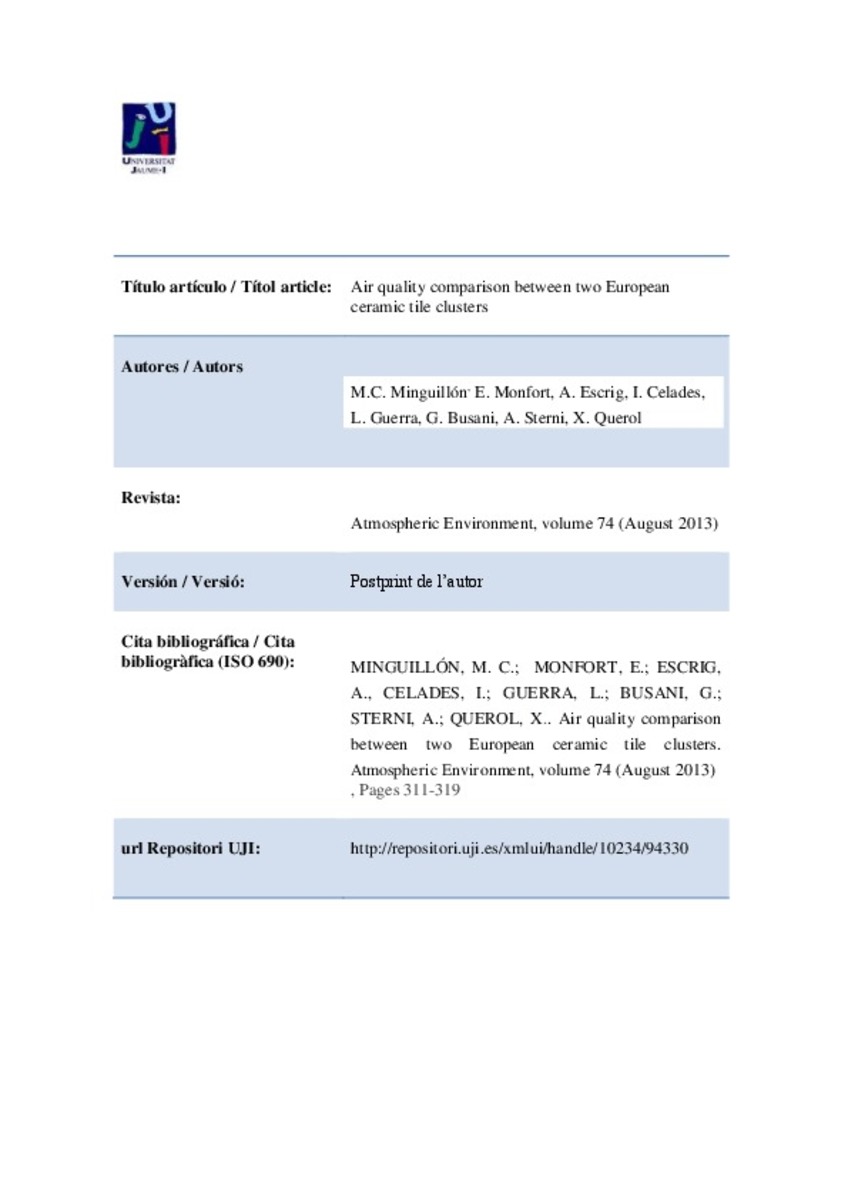Mostrar el registro sencillo del ítem
Air quality comparison between two European ceramic tile clusters
| dc.contributor.author | Minguillón Bengochea, María Cruz | |
| dc.contributor.author | Monfort, Eliseo | |
| dc.contributor.author | Escrig, Alberto | |
| dc.contributor.author | Celades López, Irina | |
| dc.contributor.author | Guerra, L. | |
| dc.contributor.author | Busani, G. | |
| dc.contributor.author | Sterni, A. | |
| dc.contributor.author | Querol, Xavier | |
| dc.date.accessioned | 2014-06-03T12:29:44Z | |
| dc.date.available | 2014-06-03T12:29:44Z | |
| dc.date.issued | 2013-08 | |
| dc.identifier.citation | MINGUILLÓN, M. C.; MONFORT, E.; ESCRIG, A., CELADES, I.; GUERRA, L.; BUSANI, G.; STERNI, A.; QUEROL, X.. Air quality comparison between two European ceramic tile clusters. Atmospheric Environment, volume 74 (August 2013) | ca_CA |
| dc.identifier.uri | http://hdl.handle.net/10234/94330 | |
| dc.description.abstract | The European ceramic tile industry is mostly concentrated in two clusters, one in Castelló (Spain) and another one in Modena (Italy). Industrial clusters may have problems to accomplish the EU air quality regulations because of the concentration of some specific pollutants and, hence, the feasibility of the industrial clusters can be jeopardised. The present work assesses the air quality in these ceramic clusters in 2008, when the new EU emission regulations where put into force. PM10 samples were collected at two sampling sites in the Modena ceramic cluster and one sampling site in the Castelló ceramic cluster. PM10 annual average concentrations were 12–14 μg m−3 higher in Modena than in Castelló, and were close to or exceeded the European limit. Air quality in Modena was mainly influenced by road traffic and, in a lower degree, the metalmechanical industry, as evidenced by the high concentrations of Mn, Cu, Zn, Sn and Sb registered. The stagnant weather conditions from Modena hindering dispersion of pollutants also contributed to the relatively high pollution levels. In Castelló, the influence of the ceramic industry is evidenced by the high concentrations of Ti, Se, Tl and Pb, whereas this influence is not seen in Modena. The difference in the impact of the ceramic industry on the air quality in the two areas was attributed to: better abatement systems in the spray-drier facilities in Modena, higher coverage of the areas for storage and handling of dusty raw materials in Modena, presence of two open air quarries in the Castelló region, low degree of abatement systems in the ceramic tile kilns in Castelló, and abundance of ceramic frit, glaze and pigment manufacture in Castelló as opposed to scarce manufacture of these products in Modena. The necessity of additional measures to fulfil the EU air quality requirements in the Modena region is evidenced, despite the high degree of environmental measures implemented in the ceramic industry. The Principal Component Analysis (PCA) identified four factors in Modena, attributed to: road traffic + metalmechanical industry, mineral, ceramic, and background; and three factors in Castelló, attributed to: mineral, ceramic (with influence of road traffic) and regional background. The additional measures to improve the air quality should be focused mainly on road traffic in Modena, and on the ceramic industry in Castelló. | ca_CA |
| dc.format.extent | 25 p. | ca_CA |
| dc.format.mimetype | application/pdf | ca_CA |
| dc.language.iso | eng | ca_CA |
| dc.publisher | Elsevier | ca_CA |
| dc.relation.isPartOf | Atmospheric Environment, volume 74 (August 2013) | ca_CA |
| dc.rights.uri | http://rightsstatements.org/vocab/CNE/1.0/ | * |
| dc.subject | Ceramic industry | ca_CA |
| dc.subject | PM | ca_CA |
| dc.subject | Metals | ca_CA |
| dc.subject | Cluster | ca_CA |
| dc.subject | Road traffic | ca_CA |
| dc.title | Air quality comparison between two European ceramic tile clusters | ca_CA |
| dc.type | info:eu-repo/semantics/article | ca_CA |
| dc.identifier.doi | http://dx.doi.org/10.1016/j.atmosenv.2013.04.010 | |
| dc.rights.accessRights | info:eu-repo/semantics/openAccess | ca_CA |
| dc.relation.publisherVersion | http://www.sciencedirect.com/science/article/pii/S1352231013002550 | ca_CA |
| dc.edition | Postprint | ca_CA |
| dc.type.version | info:eu-repo/semantics/acceptedVersion |
Ficheros en el ítem
Este ítem aparece en la(s) siguiente(s) colección(ones)
-
QUI_Articles [296]







